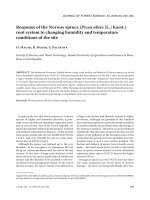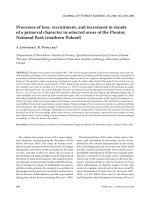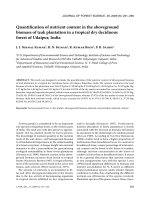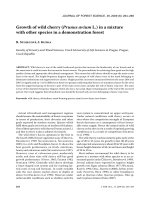Báo cáo lâm nghiệp: "Rationalization of the performance of a mobile off-road system working in the forest environment with respect to its emission load" doc
Bạn đang xem bản rút gọn của tài liệu. Xem và tải ngay bản đầy đủ của tài liệu tại đây (219.52 KB, 6 trang )
J. FOR. SCI., 54, 2008 (3): 125–130 125
JOURNAL OF FOREST SCIENCE, 54, 2008 (3): 125–130
Production processes used in the implementation
of silvicultural and logging operations in forestry
bring about large amounts of gaseous and liquid
emissions of extraneous substances. Many of them
cause the pollution of atmosphere and/or soil, sur-
face and ground water (leakages of oils, fuels, etc.).
e emissions particularly worsen the situation in
forest stands endangered by air-pollution (S
2000).
The amount of emissions produced by forest
technologies was studied by A (2000)
and by B and K (2003). e authors
determined the amount of emissions by the con-
sumption of fuels in the individual forest operations
and by the specific emission factor of individual
fuel types. D et al. (2007) published a method
of assessing the amount of emissions based on fuel
consumption and on effective work time both for
motor-manual and fully mechanized logging and
transport technology.
e engine adjustment including the injection tim-
ing, the injection pressure and the fuel pump plunger
diameter to achieve the lowest possible emissions
was studied by L et al. (2006). e problem
of injection timing adjustment was also solved by
P et al. (2005), who arrived at a conclusion
Supported by the Ministry of Education, Youth and Sports of the Czech Republic, Project No. MSM 6215648902, and the
Ministry of Agriculture of the Czech Republic, Project No. QH71159.
Rationalization of the performance of a mobile off-road
system working in the forest environment with respect
to its emission load
A. J
1
, A. S
2
, R. K
2
1
Faculty of Forestry and Wood Sciences, Czech University of Life Sciences Prague, Prague,
Czech Republic
2
Faculty of Forestry and Wood Technology, Mendel University of Agriculture and Forestry in Brno,
Brno, Czech Republic
ABSTRACT: is paper deals with the possibilities of minimizing the emissions of heterogeneous substances/pollut-
ants (SO
2
, NO
x
and NC
x
) per volume unit of processed timber, based on measurements of the design and operating
performance of a mobile off-road system working in the forest environment. e forest production system is taken to
mean the production system into which the material and resource flow and/or even the workforce flow enter. During
the production process the material, power and/or workforce flow is transformed into the final product (processed
timber, soil preparation, afforestation, etc.). Operating and/or design capacity is the control variable optimizing the
operating mode of the forest production system. e quantities of emitted pollutants related to the work unit done by
the production system represent the criterional function specifying the optimization of parameters of the mobile off-
road system working in the forest sector. e conditions for the operating mode (performance) of the mobile off-road
system working in the forest environment under which the minimum emitted pollutants related to the unit of done
work are reached have been determined. e theoretical conclusions have been verified experimentally.
Keywords: forest technology; SO
2
, NO
x
, NC
x
; optimizing; minimization
126 J. FOR. SCI., 54, 2008 (3): 125–130
that NO
x
emissions could be effectively reduced
by proper injection timing. e authors’ focus was
however the engine design.
None of the above-mentioned authors has been
engaged with a possibility of affecting the amount of
emissions through the regime of work or by using the
technique of rational performance and by specifying
the work regime at which emissions are the lowest.
Only B and L (2005) studied a pos-
sibility of fuel-related (CO
2
, SO
x
) or engine-related
(hydrocarbons, NO
x
) emissions decreased by the use
of renewable fuels and through the improvement of
the engine design and better adjustment of engines
designed for operations in the forest.
Nevertheless, should the machine (system) be
already made, emissions can be optimized by its
suitable rational performance. e most important
measures compensating the environment con-
tamination by extraneous substances are preventive
measures that can be applied on a larger part of the
area of endangered forest ecosystems. According to
J (1992), the measures consist in the selec-
tion of appropriate and environment-friendly tech-
nologies including the choice of suitable machinery,
and in using acceptable methods for the employment
of machines with the rational performance. Pos-
sibilities to determine the rational performance of
machines are further discussed in this paper.
e objective of this paper was to present some
results from the analysis and from the determina-
tion of mathematic conditions required for reaching
minimum specific emissions from logging and trans-
port operations in the forest in relation to extracted
mass unit.
MATERIALS AND METHODS
e outline of deduction of the criterional function
of specific heterogeneous substance emissions relat-
ed to the timber yield volume unit was carried out in
view of the objective mentioned above. Mathematical
conditions for determination of the local extreme
of the function of specific heterogeneous substance
emissions were determined in dependence on the
performance and physical significance of the terms of
inequalities or equations specifying the above-men-
tioned extreme of specific heterogeneous substance
emissions were expressed. e papers published by
J et al. (1991), B (1956), W
(1954), S (2000) and J and M
(2003) represented the methodological basis.
eoretical conclusions were verified experimen-
tally by monitoring the emissions of a Swedish-made
TERRI
20-40 forwarder.
Qualitative specification of factors affecting
emissions of heterogeneous substances
Logging and transport systems of different design
performance, reaching different specific amount of
material consumption, are used in the field of forest
management. e specific heterogeneous substance
emissions are proportional to the different used
systems.
Factors affecting specific resource and material
consumption:
– e change in all assemblies of logging and transport
systems affecting the consumption of resources,
material and/or labour is not directly proportional
to an increase in the design performance;
– e changed investment intensity of logging and
transport systems is not proportional to the
change in performance. Such a situation arises
due to the use of different unified assemblies
manufactured in different typified sizes, i.e. their
use usually leads to a certain oversize;
– Dimensional changes in stages (material flows
processed by the logging and transport systems),
resulting from the changed performance of the
system, do not always cause a change in power
and material consumption and thus a change in
heterogeneous substance emissions proportional
to the changed performance, which is in general
the function of material flow velocity and cross
section.
When analyzing these effects in greater detail, not
only the kind of the logging and transport system but
also particularly the method of reaching its design
performance have to be considered.
Possibilities of increasing the design performance
of forest systems:
– Increased material flow range
By increasing the number of working assemblies
(e.g. cutting mechanisms – used particularly for
silvicultural operations);
By extending the working assembly (e.g. extension
of the cutting mechanism length – cutter bars);
– By extending the cross sections within roads
where the material is transported;
– By increasing the maximum working capacity
(performance).
Determination of the optimum regime of the
logging and transport system from the aspect
of specific heterogeneous substance emissions
related to the performance unit
Resources, material and/or workforce enter into
the logging and transport system. Resources and
J. FOR. SCI., 54, 2008 (3): 125–130 127
material are transformed during the production
process, thus creating the resultant product, i.e.
processed timber. e intensity of labour is con-
trolled by the controllers specifying the design and
operating performance (Fig. 1).
Emissions of heterogeneous substances, reflecting
losses of energy during the process of production
depend on the rate of work of the logging and trans-
port system.
J and M (2003) show that the follow-
ing equation is valid for the expression of quantities
of emissions of heterogeneous substances from tim-
ber logging and transport occurring due to energy
transformation:
m
E
× Q
E
M
EE
= –––––––––––– × S
E
(W
K
, W
P
) (kg) (1)
η
CE
(W
K
, W
P
)
where: M
EE
– quantities of emissions from timber logging
and transport generated by the work of the
logging and transport system as a conse-
quence of energy transformation (kg),
m
E
– the quantity of energy resources (Diesel
fuel, petrol) necessary for logging and
production (kg),
W
p
– the operating performance of the system
(m
3
/s),
W
k
– the design performance of the system
(m
3
/s),
S
E
(W
p
,W
k
) – specific inherent emissions generated
by energy and material transformation
during the production process depend-
ing on design and operating performance
(kg/kJ),
Q
E
– the specific energy of the resource (kJ/kg),
η
CE
(W
k
, W
p
) – the efficiency of resource transforma-
tion into the resultant product depending
on design and operating performance.
e following relation is valid for the total volume
produced by the logging and transport system during
the transformation of energy quantum Q
E
m
E
× Q
E
W
CE
= ––––––––––––––––– (m
3
) (2)
Q
V
× η
CE
(W
K
, W
P
)
where: W
CE
– the total production volume of the system
produced due to energy transformation (m
3
),
Q
V
– the specific production energy which has to be
supplied to the logging and transport system
per unit of production (kJ/m
3
).
e time derivations of equation (1) can be ex-
pressed in the following form, provided that the
values Q
E
, S
E
and η
CE
are constants for the analyzed
time:
∂m
E
∂M
EE
∂t
× Q
e
–––––– = –––––––––––– × S
E
(kg/s) (3)
∂t
η
CE
(W
K
, W
P
)
According to J and M (2003) the
following relation can be applied to quantities of
heterogeneous substance emissions related to the
performance unit of the mobile off-road system
∂m
E
∂M
EE
1 ∂t
× Q
E
×
S
E
Q = –––––– × ––––––––––– = ––––––––––––––– ×
∂t W
C
(W
K
, W
P
) η
CE
(W
K
, W
P
)
1
× ––––––––––– (kg/m
3
) (4)
W
C
(W
K
, W
P
)
where: Q – specific heterogeneous substance emissions
generated per volume unit (kg/m
3
),
t – the time (s),
∂
M
EE
––––– –
∂t
∂m
E
––––– –
∂t
The following equation is valid for the system
performance
∂W
CE
W
C
= –––––– (m
3
/s) (5)
∂t
e necessary conditions shown below are valid
for the extreme of the function of specific hetero-
geneous substance emissions, related to the volume
unit of processed mass as the function of design and
operating performance:
∂
2
M
EE
(W
K
, W
P
)
–––––––––––––– = 0 (kg/m
3
) (6)
∂t ×
∂W
K
∂
2
M
EE
––––––––– = 0 (kg/m
3
) (7)
∂t,
∂W
p
logging and transport system
energy
material
operating
efficiency
construction
performance
processed timber
Logging and transport system
Processed timber
Construction
performance
Operating
efficiency
Material
Energy
Fig. 1. Flow sheet of the logging and
transport system
the quantities of heterogeneous substance
emissions from timber logging and trans-
port per time unit generated as a conse-
quence of energy transformation (kg/s),
the quantities of resources supplied per
time unit (kg/s).
128 J. FOR. SCI., 54, 2008 (3): 125–130
After realization of all operations as mentioned
above and after modifications (J, M
2003) we derive the expressions deciding the sign of
partial derivations in the form
∂ƒ
E
(W
K
, W
P
) ƒ
E
∂η
C
(W
K
, W
P
)
––––––––––––– – ––––––––––– × –––––––––––– –
∂W
K
η
CE
(W
K
, W
P
)
∂W
K
ƒ
E
∂W
C
(W
K
, W
P
)
– –––––––––––– × ––––––––––––– > 0 (8)
W
C
(W
K
, W
P
) ∂W
K
(relation (8) is valid for the field of higher design
performance)
∂ƒ
E
(W
K
, W
P
) ƒ
E
∂η
C
(W
K
, W
P
)
–––––––––––– – ––––––––––– × –––––––––––– –
∂W
P
η
CE
(W
K
, W
P
)
∂W
P
ƒ
E
∂W
C
(W
K
, W
P
)
– –––––––––––– × ––––––––––––– < 0 (9)
W
C
(W
K
, W
P
) ∂W
P
(relation (9) is valid for the field of lower design
performance)
where
∂M
EE
ƒ
E
= ––––– × Q
E
× S
E
(W
K
, W
P
) (kg/s) (10)
∂t
f
E
– the emission flow caused by energy transformation in
the production process.
By a similar analysis we can find the relations
specifying the behaviour of the function of specific
emissions in view of the control parameter W
P
, i.e.
operating efficiency (J, M 2003).
RESULTS
Basic mathematical analyses of the problem in
question were carried out in the scope of our work
with the objective to determine the optimum oper-
ating efficiency of logging and transport production
systems with minimizing heterogeneous substances
generated by the energy flow conversion during its
transformation to the resulting product.
The constructed models were verified by the
operation of a TERRI 20-40 forwarder (Figs. 2 to
4). Specifications of the conditions of work of the
forwarder TERRI 20-40 and its technical parameters
were presented in J and M (2003).
e experiments have shown that the function of
specific emission values always creates the minimum.
e optimum operating efficiency ranges in depend-
ence on the minimized emission constituents,
0
5,000
10,000
15,000
20,000
25,000
0 500 1,000 1,500 2,000 2,500 3,000
WP (m
3
/month)
NCx (g/month) _ _ _
0
1
2
3
4
5
6
7
8
9
10
Specific NCx (g/m
3
) _____
0
500
1,000
1,500
2,000
2,500
3,000
0 500 1,000 1,500 2,000 2,500 3,000
WP (m
3
/month)
SO
2
(g/month) _ _ _
0.95
1.00
1.05
1.10
1.15
Specific SO
2
(g/m
3
) _____
Fig. 2. Dependence of specific NC
x
on
operating efficiency – TERRI 20-40
Fig. 3. Dependence of specific SO
2
on
operating efficiency – TERRI 20-40
W
p
(m
3
/month)
NC
x
(g/month)
NC
x
(g/m
3
)
W
p
(m
3
/month)
SO
2
(g/m
3
)
W
opt
W
opt
J. FOR. SCI., 54, 2008 (3): 125–130 129
namely: NC
x
– 1,470 m
3
/month, SO
2
– 1,310 m
3
per
month
and NO
x
– 2,100 m
3
/month. Selection of the
optimum efficiency of the forwarder depends on
the mathematical weight of emission constituents
which can be determined by the significance of their
impacts on the environment (S 2000). Ranges
of produced emissions with the changing operating
efficiency are shown in Table 1.
It follows from relations (8) and (9) that the design
of the mobile off-road system affects both the flow
of heterogeneous substance emissions, i.e. it affects
the inherent emission, and the efficiency of energy
transformation to the resulting product, i.e. it affects
the efficiency of combustion. Similarly, the value of
operating efficiency at which the mobile off-road sys-
tem works affects the transformation efficiency and
intensity of production of heterogeneous substances.
e thesis (D 1980) that the quantity of
dissipative energy is the measure of the environmen-
tal purity (emissions of heterogeneous substances) of
work of the production system is valid in general. e
thesis has been confirmed by the practical analysis
of work of the mobile system mentioned above in
dependence on the rate of its work.
DISCUSSION
e mathematical formulation of the production
system behaviour (in logging and transport op-
erations, but also valid for silvicultural operations)
shown in this paper has confirmed that it can repre-
sent a basis for the determination of conditions the
fulfilment of which leads to the optimization based
on the determination of the minimum heterogene-
ous substance emissions related to the performance
unit.
us, the solution provides an optimization of
production system operations from the aspect of
the minimum level of produced heterogeneous sub-
stances related to the production unit and the mini-
mum costs related to the production unit, necessary
for the transformation of production system into
an environmentally cleaner method of production.
e general thesis (D 1980) has been
confirmed: by minimizing the dissipative energies
produced by the production system, we can reach the
operating mode of the production system character-
ized by the optimum work of the system with respect
to environmental cleanness of the work.
Experimental measurements carried out on the
TERRI 20-40 forwarder have revealed and substanti
-
ated that the upper limit of the operating efficiency
recommended by the manufacturer (W
p
÷ 2,000 m
3
per month) is too high with respect to the emissions
of heterogeneous substances.
0
100
200
300
400
500
600
700
0 500 1,000 1,500 2,000 2,500 3,000
WP (m
3
/month)
NO
x
(g/month) _ _ _
0.0
0.1
0.2
0.3
0.4
Specific NO
x
(g/m
3
) _____
Fig. 4. Dependence of specific NO
×
on
operating efficiency – TERRI 20-40
Table 1. Sensitivity analysis of the dependence of hetero-
geneous substance emissions on the operating performan-
ce of TERRI 20-40 system
W
p
(m
3
/month)
NC
x
SO
2
NO
x
minimum (g/m
3
)
7.79 1.00 0.25
deviation from minimum (%)
1,300 0.19 0.02 11.97
1,310 0.16 0.00 11.74
1,390 0.00 0.07 9.90
1,400 0.01 0.08 9.69
1,500 0.05 0.31 7.67
1,600 0.07 0.69 5.93
1,700 0.36 1.24 4.46
1,800 0.82 1.94 3.27
1,900 1.44 2.81 2.35
2,000 2.32 3.85 1.70
2,100 3.17 5.04 0.00
W
p
(m
3
/month)
NO
x
(g/m
3
)
W
opt
130 J. FOR. SCI., 54, 2008 (3): 125–130
It has been proved that the optimum operating
efficiency of the TERRI 20-40 system ranges from
1,000 to 1,500 m
3
/month.
R ef er en ces
ATHANASSIADIS D.,
2000. Energy consumption and ex-
haust emissions in mechanised timber harvesting opera-
tions in Sweden. Science of the Total Environment, 255:
135–143.
BELLMAN R.
, GLICKSBERG O., GROSS O., 1956. On the
bang-bang control problem. Quarterly of Applied Mathe-
matics, 14: 11–18.
BERG S.,
KARJALAINEN T., 2003. Comparison of green-
house gas emissions from forest operations in Finland and
Sweden. Forestry, 73: 271–284.
BERG S.,
LINDHOLM E., 2005. Energy use and environmen-
tal impact of forest operations in Sweden. Journal of Cleaner
Production, 13: 33–42.
DIAS A.C., ARROJA L.,
CAPELA I., 2007. Carbon dioxide
emissions from forest operations in Portuguese eucalypt
and maritime pine stands. Scandinavian Journal of Forest
Research, 22: 422–432.
DUVIGNEAUD P.,
1980. La synthèse écologique. Paris, Doin
Éditeurs: 296.
JANEČEK A.,
MIKLEŠ M., 2003. Ecological aspects of mobile
systems operated in terrain conditions. Research Agricul-
ture Engineering, 49: 119–193.
JANEČEK A.
et al., 1991. Úvodní systémová analýza mo-
delování negativního působení lesní techniky na ekosys-
témy. Strnady, VÚLHM: 143.
JANEČEK A.
et al., 1992. Úvodní systémová analýza mo-
delování negativního působení lesní techniky na ekosys-
témy. Strnady, VÚLHM: 155.
LEJNY D., LUO Y.,
CHAN T., 2006. Optimization of exhaust
emissions of a diesel engine fuelled with biodiesel. Energy
and Fuels, 20: 1015–1023.
PARLAK A., YASAR H., HASIMOGLU C.
et al., 2005. e
effects of injection timing on NO
x
emissions of a low heat
rejection indirect diesel injection engine. Applied ermal
Engineering, 25: 3042–3052.
SKOUPÝ A.,
2000. Quality of Technologies for Sustainable
Forest Management. In: KADLEC J., KLVAČ R., VOJÁČEK
A. (eds), Forest and Wood Technology vs. Environment.
Brno, MZLU: 327–333.
WIENER N., 1954. e Human Use of Human Beings. Cyber
-
netics and Society. 2
nd
Ed. New York, Garden City: 199.
Received for publication October 23, 2007
Accepted after corrections January 10, 2008
Racionalizace výkonnosti mobilního terénního systému pracujícího v lesním
prostředí z hlediska jeho zátěže emisemi
ABSTRAKT: Článek se zabývá možnostmi minimalizace emise cizorodých látek (SO
2
, NO
x
a NC
x
), vztahujících se na
jednotku objemu zpracovaného dříví, a to na základě měření konstrukční a provozní výkonnosti mobilního terénního
systému pracujícího v lesním prostředí. Lesní výrobní systém je zde chápán jako výrobní systém, do něhož vstupují
materiálový a energetický tok a případně i tok pracovních sil. V době probíhajícího výrobního procesu je tok mate
-
riálu, energie nebo pracovní síly transformován na konečný produkt (zpracované dříví, příprava půdy, zalesňování
atd.). Řídící veličinou optimalizující pracovní režim lesního výrobního systému je provozní, případně konstrukční
výkonnost. Kriteriální funkcí specifikující optimalizaci parametrů mobilního terénního systému pracujícího v lesním
hospodářství je množství emitovaných cizorodých látek, vztahujících se na jednotku práce vykonané výrobním sys-
témem. Jsou stanoveny podmínky pro režim práce (výkonnosti) mobilního terénního systému pracujícího v lesním
prostředí, za kterých je dosaženo minima emitovaných cizorodých látek, vztahujících se na jednotku vykonané práce.
Teoretické závěry jsou experimentálně verifikovány.
Klíčová slova: lesnická technologie; SO
2
, NO
x
, NC
x
; optimalizace; minimalizace
Corresponding author:
Ing. R K, Mendelova zemědělská a lesnická univerzita v Brně, Lesnická a dřevařská fakulta,
Lesnická 37, 613 00 Brno, Česká republika
tel.: + 420 545 134 528, fax: + 420 545 211 422, e-mail:









